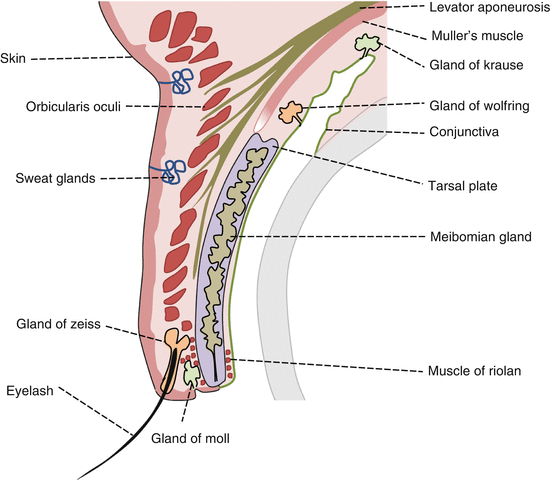(1)
University of Sydney, Sydney, Australia
Protective Mechanisms of the Eye
Overview
Several mechanisms exist to protect the eye from external injury.
Mechanisms of potential damage to the eye include:
(a)
Mechanical insult
(b)
Chemical insult
(c)
Biological insult
(d)
Electromagnetic radiation
Mechanical Insult
Chemical Insult
1.
Eyelid closure
Reflex blinking provides rapid closure of the eye in response to splash or foreign body sensation.
2.
Bell’s phenomenon
A normal Bell’s phenomenon provides involuntary upward rotation of the globe on lid closure, removing the cornea from noxious stimuli [9].
3.
Tears
Tear flow increases dramatically in response to mechanical or noxious stimuli [10].
This causes dilution and washout of the irritant.
Biological Insult
1.
Tear film and conjunctiva (see Chap. 2, The Ocular Surface)
The tear film has several bacteriostatic properties [14]:
(i)
(ii)
Aqueous layer
The aqueous layer has several antibacterial constituents including secretory immunoglobulin A (IgA), lysozyme, and lactoferrin.
(iii)
Normal conjunctival flora
The normal bacterial flora may inhibit survival of more pathogenic species [16].
(iv)
Natural killer cells
Present in the conjunctiva, natural killer cells may have a role in restricting the spread of viral infection or tumors.
2.
Corneal epithelium and Bowman’s layer
These act as physical barriers against ocular penetration by microbial pathogens.
3.
Descemet’s membrane
Descemet’s membrane is resistant to proteolysis in severe corneal infections, maintaining the integrity of the globe [17].
Electromagnetic Radiation (EMR) Toxicity
The primary function of the eye is to detect and interpret light information from the external world.
However, excessive EMR can be damaging to the eye, and several protective mechanisms exist:
1.
Eyelid closure
The dazzle reflex: bright light induces reflexive blinking.
2.
Pupil constriction
Rapid pupil constriction in response to bright light limits excessive radiation exposure to the ocular media internal to the iris [18].
3.
Light absorption by ocular tissues (Table 1.1)
Waveband | Domain | Wavelength (nm) | Absorption by anterior ocular media | Absorption by retinal and choroidal pigments (non-photoreceptor) |
|---|---|---|---|---|
Ultraviolet (UV) | UV-C | 200–280 | Cornea and sclera | |
UV-B | 280–315 | Cornea and sclera | ||
UV-A | 315–400 | Crystalline lens | ||
Visible light | 400–780 | Xanthophylls, hemoglobin, and melanin | ||
Infrared (IR) | IR-A | 780–1400 | Haemoglobin and melanin | |
IR-B | 1400–3000 | Cornea and sclera | ||
IR-C | 3000–10,000 | Cornea and sclera |
Absorption of nonvisible optic radiation prevents harmful levels of EMR from damaging the eye.
The crystalline lens absorbs UV-A.
Antioxidants in the lens and macula prevent excessive UV-induced oxidative damage.
The yellow macular carotenoid xanthophyll pigments in Henle’s fibre layer absorb short wavelength radiation [22]. They minimize blue light incident to the fovea and reduce chromatic aberration and glare.
Hemoglobin and melanin, principally found in the choroid, absorb excessive light and IR radiation. This results in excessive heat generation; the choroidal circulation acts as a heat sink to dissipate thermal energy [23].
Eyelids
Overview
The eyelids are important for protection and maintenance of normal ocular health and function [24].
1.
2.
Maintenance of globe position
The eyelids apply gentle posterior pressure on the globe to counteract forward pressure from orbital tissues behind the globe.
3.
4.
Eyelid glands
The eyelid contains glands with secretions that add to the tear film.
Structure
1.
2.
The anterior lamella functions as a single unit, consisting of skin, muscle (orbicularis oculi (OO)), and associated glands [29, 30].

(i)
Skin
The eyelid skin is thin, allowing rapid and large movements on eyelid opening and closure.
(ii)
Get Clinical Tree app for offline access
Muscle: the orbicularis oculi (Fig. 1.3)


Fig. 1.3
Divisions of orbicularis oculi
The orbicularis oculi (OO) is a flat, elliptical muscle surrounding the orbital margin and extending onto the cheek, eyelids, and around the lacrimal sac.
OO has three functional divisions (Table 1.2) [31, 32].
Table 1.2
Functional divisions of the orbicularis oculi muscle
Division
Location
Function
Pre-tarsal
Overlying the tarsal plate
Light blink
Pre-septal
Overlying the orbital septum
Blink and sustained closure
Orbital
Outermost portion
Wink and sustained closure
Stay updated, free articles. Join our Telegram channel

Full access? Get Clinical Tree




